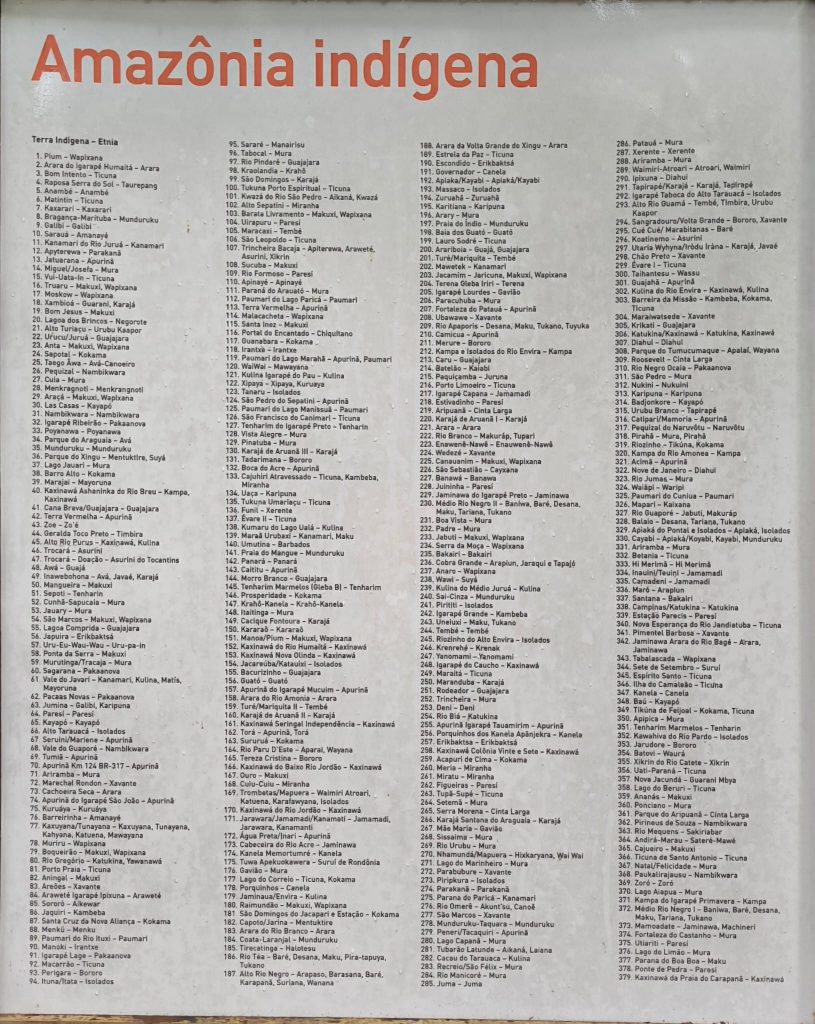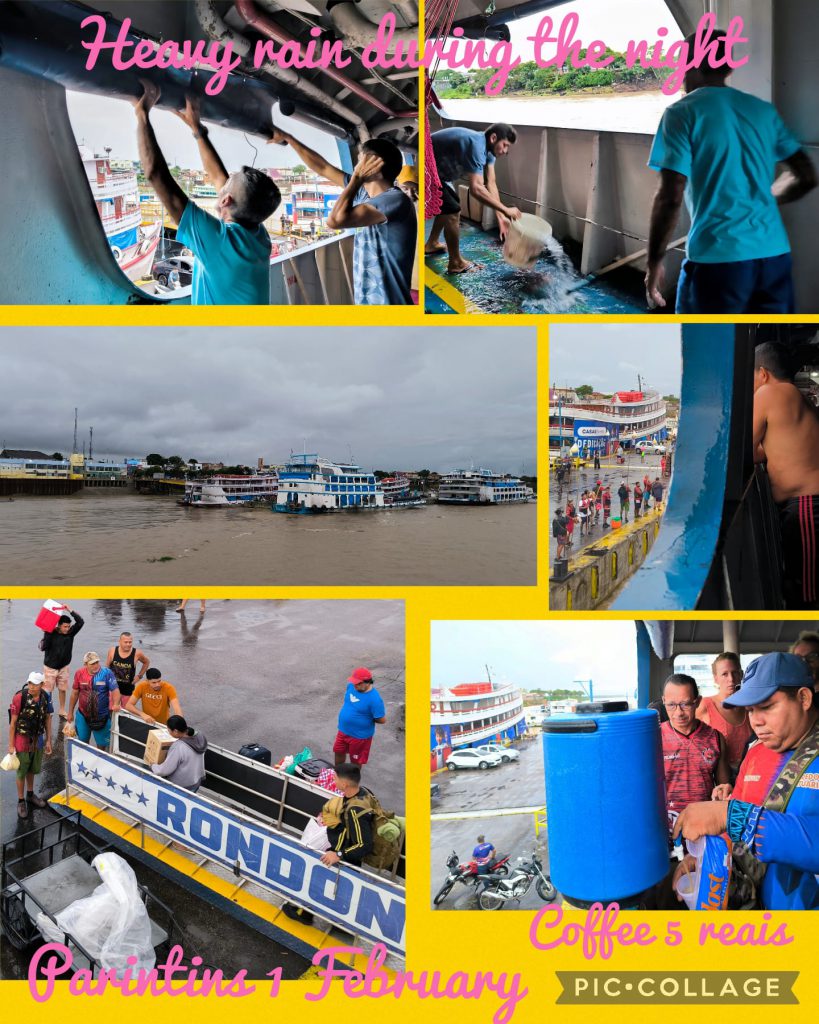The Amazon River
The 6,400km-long River is the world’s largest river by discharge volume of water and longest river system passing through Brazil, Columbia, Peru and Venezuela with Brazil holding by far the largest portion of the River. The headwaters of the Mantaro River in Peru is considered Amazon’s most distant source and the Solimoes River meets the Negro River forming the Amazon at the Meeting of Waters at Manaus, the largest city on the river. The Amazon basin is the world’s largest drainage basin with an area of 7 million square kilometre.
People arrived in the area between 10,000-30,000 years ago. There is ample evidence that the area were home to complex and large-scale indigenous societies with more than three million living around the Amazon. The pre-Columbian Amazon populations might probably range between 8-10 million. Today about 1.5 million of the Amazon population is indigenous, distributed across some 380 ethnic groups.
I booked through Claudio, an agent in Manaus, a cabin on a river ferry Amazon Star and spent five days sailing downstream from Manaus to Belem (31 January to 4 February). Claudio drove me to the pier before 10 am but the boat did not set sail after 12 noon. It was a great pity that despite my request, Claudio did not take me to the old part of Manaus again to see and take pictures of the Lisbon Market and other historic buildings.
Life on the Boat
I have read some interesting notes from travellers on this 1500-km long river journey. Claudio said I would have a nice cabin and chances to leave the boat to explore the ports of call. I had Suite 13 on deck 2. But it is a steel windowless cabin with a bunk bed and toilet. Furthermore, passengers were not allowed to get off the boat!
Facilities. The boat launched in 1981 is very basic. It carries vehicles, goods and passengers mostly Brazilians and backpackers who sleep with their hammock. Given my age and mobility problem, I took a cabin with toilet for single occupancy (the published price is R2500 = about USD520). I was disappointed as I had a bunk bed and without windows. I was provided with a plastic chair which I could use for sitting outside to get fresh air and natural light. The dining facility is very basic. In a nut shell, it is the most basic and uncomfortable boat that I have ever taken. As all announcements were in Portuguese and most of the helpful locals did not speak English, I had hardly any clue what was going on and to expect.
No Landing. The boat made brief stops for an hour or two in a couple of ports each day. But it spent fourteen hours in Santeram. Whenever the boat arrived at the pier, there would be a flurry of activities with food/drink peddlers hoisting their commodities to passengers on the boat. Then they would rush onto the boat to sell after passengers had disembarked.
Food. There is a small restaurant that serves breakfast (R10/15) on deck 1, lunch / dinner (R20) and a small bar on deck 3. The bar sells beer, soft drinks and snacks without comfortable sitting area. The breakfast is good while lunch and dinner are basically the same with chicken, beef and fish that come with spaghetti, rice, bean and salad. I do not find the food appealing. So I had to force myself to take one main meal a day.
Space. The boat is fairly small with hundreds of hammocks taking up the decks 2 and 3. There is not much space to walk around without bumping into people. The only free space available is the bar area which is also a smoking area on deck 3 and the top deck. But there is no bench to sit and relax. As I have a problem sitting on the hard floor and in getting up, I found no comfortable space on the boat to sit and enjoy the scenery.
Scenery. The river with its brown earthly colour water, is impressive, expansive and powerful. Without wave, the boat sailed along smoothly. There are always activities on and along the river with fishing boats, small boats, barges carrying vehicles and goods, passenger ferries, people living along the river, cattle in the field, birds and vegetation. In Santeram, I saw dolphins as well. The section of the river I enjoyed most is from Gurupa to Belem on 3 and 4 February.
People. I was the only Chinese on the boat and many locals thought I was Japanese. They were curious and always asked where I was from. Though I can’t speak and understand Portuguese, I always told them I am Chinese from Hong Kong. I have only spoken to a Brazilian doctor who wants to practise his English before he got off at Santeram. There were about 15 foreigners on the boat including six French young people. We talked and I enjoyed their company.
After leaving Gurupa, I noticed some passengers started to throw bags of food (biscuits etc.) in plastic bags to children who raced to greet the boat in their rowing boats. Why? Sweet, biscuits etc are non-essential for maintaining good health. Such practice can encourage unnecessary greed and desire: they can use their time more fruitfully by fishing. Above all, I am concerned about the use of plastic bags which would do more harm to the environment.
How I Spent My Time
Given my hip problem, I should not remain in a position for too long. Hence, I mindfully kept walking slowly around the boat and stood looking at the fast-moving river. I enjoyed people-watching, taking photos and sitting on my plastic chair outside my room to read. I am glad to finish reading a book and a few Buddhist scriptures. I watched lectures on YouTube by Professor Law on Sandhinirmocana Sutra whenever I had good internet connection. After watching sunset, I retreated to my cabin and lay down to rest. On average I spent eight to ten restless hours in bed. As a result, I remained tired and lifeless. I watched and experience life on a slow lane and was glad to get off the boat after 97 hours on the boat. In brief, it is the calmest and most uneventful journey I have ever made.
Belem
Located on the banks of Guajara Bay and the Guama River and founded in 1616, Belem is the capital of the state of Para. It has experienced moments of plenitude: known as “Tropical Paris”, it was prosperous during the golden period of rubber in the 20th century with many historic buildings.
I was almost the last passengers to leave the boat as I had to wait for Ulisses, my guide to help me carry my 23-kg suitcase off the boat. He came with his son who was the driver. He took me to see the Fish Market which is the largest open air market in South America (I was told), and we walked around the old port and the fortress which though small is well-restored with a good museum with exhibits on the indigenous people before the founding of Belem in 1616. The old town which is the commercial trading area with colourful colonial European architecture is sadly derelict. There are many homeless people sleeping on the street near the old port.
The buildings next to the fortress including the Cathedral, the convent and a nobleman’s house are impressive. But the cathedral was closed. Ulisses took me Mangal das Garcas, a lovely oasis in the city with egrets, parrots, macaw, red ibis, flamingo, iguana etc. He planned to show me the Basilica Sanctuary of Our Lady of Nazareth of Exile which is considered the most beautiful church in Belem. Unfortunately, it was closed. I had a photo stop at the Paz Theatre modelled after La Scala of Milan before I was dropped off at the dock to spend three hours on my own. At 6pm, Ulisses dropped me at the airport for a flight to Sao Luis at 1 am on 5 February.




















